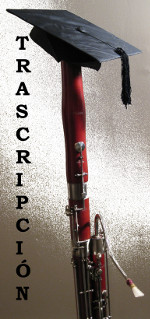Practicing
Weissenborn Study #42
Weissenborn Opus 8/2, Study #42 for advanced bassoon students. A few
performance suggestions. The golden rule. By Terry B. Ewell, Bassoon
Digital Professor. Translated by Elena Iakovleva. BDP#150.
www.2reed.net.
Practicando el estudio de Weissenborn Nº42
Weissenborn
Opus 8/2, estudio Nº42 para estudiantes avanzados de fagot. Algunas
sugerencias interpretativas. La regla de oro. Por Terry B. Ewell,
Profesor Digital de Fagot. Traducido y doblado por Elena Iakovleva y
Carlos Gabriel Arias Sánchez. BDP#150. www.2reed.net.
TUTORIAL Руководство
1. Welcome, this is Terry Ewell. There is a reason that bassoon concertos are not written in B major! It is very difficult to achieve smooth connections and facile fingerings in this key. You will need to apply the practice tools provided in the earlier videos to achieve even fingerings in this study. Make good use of rhythms and sprints!1. Bienvenidos, éste es Terry Ewell. Hay una razón por la que no se han escrito conciertos para fagot en Si mayor! Es muy difícil lograr conectar las notas y encontrar la comodidad en las digitaciones. Para lograr una digitación pareja, usted tendrá que aplicar las herramientas de estudio provistas en los videos previos. Haga un buen uso de la variedad de ritmos y las carreras!
2. Make a four measure phrase in line one, not two measure phrases.
2. En el primer pentagrama, forma una frase de cuatro compases, no dos de dos.
3. Don’t play like this:
3. No toque así:

4. En lugar de eso, toque de esta forma:

5. En el tercer pentagrama, dé un toque a la llave del Do# para facilitar la ligadura al Re#4.

6. En el sexto pentagrama, destapa medio orificio y use el portavoz para facilitar la ligadura al Sol#4.

7. Asegúrese de mantener el Fa doble sostenido durante todo el compás, en el séptimo pentagrama.

8. La segunda y última indicación acerca de la respiración dada por Weissenborn en los estudios, aparece en el tercer compás del séptimo pentagrama. Esto me indica que él desea que se toque desde el calderón del quinto pentagrama hasta la indicación para respirar, sin una respiración adicional. Además, el intérprete no debería volver a tomar aire hasta el próximo calderón, en el octavo pentagrama.
REFLECTION Reflexión
9. “And the second is like it: ‘You shall love your neighbor as yourself.’ (NKJV, Matthew 22: 39).9. El segundo se parece a este: “Ama a tu prójimo como a ti mismo”. (NVI, Mateo 22:39)
10. In the prior reflection we examined the first commandment given by Jesus. Here is the second commandment. This is commonly called the “golden rule,” and it beautifully sums up how we should relate to other people.
10. En la reflexión anterior examinamos el primer mandamiento dado por Jesús. Aquí está el segundo. Esto es comúnmente llamado “la regla de oro”, y su belleza resume cómo deberíamos relacionarnos con la otra gente.
11. There really are two parts to this commandment. You can’t love others if you hate yourself. So loving others must begin with caring for all aspects of your own life. Out of that self-care then can come compassion and care for others.
11. En realidad hay dos partes en este mandamiento. No puede amar a otros quien se odia a sí mismo. Así que amar a otros debe comenzar por cuidar de todos los aspectos de la vida de uno mismo. De ese amor propio puede luego nacer la compasión y el cuidado por los demás.
